Rural Application of a Low-Pressure Reverse Osmosis Desalination System Powered by Solar–Photovoltaic Energy for Mexican Arid Zones
Abstract
:1. Introduction
2. Photovoltaic-Powered RO Desalination
3. Description of the Study Area
4. Methodology
4.1. Characterization of the Study Area and Identification of Users’ Water Requirements
4.2. Design and Experimental Testing of the LPRO-PV System
4.3. Installation of the LPRO-PV System On-Site
4.4. Perception of the Performance, Maintenance, and Use of the LPRO-PV System
5. Results
5.1. Evaluation of the LPRO-PV System under Laboratory Conditions
5.2. Cost Analysis
- Plant life expectative (n) is 20 years;
- Operating and maintenance costs are estimated as 20% of plant annual payment. Close to 13% is related to maintenance. Service system includes replacement of the pretreatment filters;
- Annual rate of membrane replacement is 10%;
- Interest rate is 8% when financing is required.
5.3. Perception of Performance, Maintenance, and Use of the LPRO-PV System
6. Conclusions
Author Contributions
Funding
Institutional Review Board Statement
Informed Consent Statement
Acknowledgments
Conflicts of Interest
References
- Chaibi, M.T. An overview of solar desalination for domestic and agriculture water needs in remote arid areas. Desalination 2000, 127, 119–133. [Google Scholar] [CrossRef]
- Kharraz, J.A.; Richards, B.S.; Schäfer, A.I. Autonomous Solar-Powered Desalination Systems for Remote Communities. In Desalination Sustainability: A Technical, Socioeconomic, and Environmental Approach; Hassan, A.A., Ed.; Elsevier: Amsterdam, The Netherlands, 2017; pp. 75–125. [Google Scholar]
- Schäfer, A.I.; Hughes, G.; Richards, B.S. Renewable energy powered membrane technology: A leapfrog approach to rural water treatment in developing countries? Renew. Sustain. Energy Rev. 2014, 40, 542–556. [Google Scholar] [CrossRef]
- Ibrahim, M.M. Technical and Economic Comparison between Solar and Wind Energy Supplying Desalination System. J. Sustain. Dev. Energy Water Environ. Syst. 2022, 10, 1080382. [Google Scholar] [CrossRef]
- Pimentel da Silva, G.D.; Sharqawy, M.H. Techno-economic analysis of low impact solar brackish water desalination system in the Brazilian Semiarid region. J. Clean. Prod. 2020, 248, 119255. [Google Scholar] [CrossRef]
- Dehesa-Carrasco, U.; Ramírez-Luna, J.; Calderón-Mólgora, C.; Villalobos-Hernández, R.; Flores-Prieto, J.J. Experimental evaluation of a low pressure desalination system (NF-PV), without battery support, for application in sustainable agriculture in rural areas. Water Sci. Technol. Water Supply 2017, 17, 579–587. [Google Scholar] [CrossRef]
- De Munari, A.; Capão, D.P.S.; Richards, B.S.; Schäfer, A.I. Application of solar powered desalination in a remote town in South Australia. Desalination 2009, 248, 72–82. [Google Scholar] [CrossRef]
- Ahmad, G.E.; Schmid, J. Feasibility study of brackish water desalination in the Egyptian deserts and rural regions using PV systems. Energ. Convers. Manag. 2002, 43, 2641–2649. [Google Scholar] [CrossRef]
- Alemán-Nava, G.S.; Casiano-Flores, V.H.; Cárdenas-Chávez, D.L.; Díaz-Chavez, R.; Scarlat, N.; Mahlknecht, J.; Dallemand, J.-F.; Parra, R. Renewable energy research progress in Mexico: A review. Renew. Sustain. Energy Rev. 2014, 32, 140–153. [Google Scholar] [CrossRef]
- Nuño, N.; Muela, J.; Hausmann-Muela, S.; Cevallos, M.; Harting, S.M.; Christen, A.; Mäusezahl, D. The meanings of Water: Socio-Cultural Perception of Solar Disinfected (SODIS) Drinking Water in Bolivia and Implications for its Uptake. Water 2020, 12, 442. [Google Scholar] [CrossRef]
- Ghermandi, A.; Messalem, R. Solar-driven desalination with reverse osmosis: The state of the art. Desalination Water Treat. 2009, 7, 285–296. [Google Scholar] [CrossRef] [Green Version]
- Alhaj, M.; Al-Ghamdi, S.G. Integrating concentrated solar power with seawater desalination technologies: A multi-regional environmental assessment. Environ. Res. Lett. 2019, 14, 074014. [Google Scholar] [CrossRef]
- Censo de Población y Vivienda 2020. Access to INEGI. Available online: https://www.inegi.org.mx/app/cpv/2020/resultadosrapidos/default.html?texto=Samalayuca (accessed on 12 May 2021).
- SEMARNAT; CONANP. Programa de Manejo—Área de Protección de Flora y Fauna Médanos de Samalayuca; Gobierno de México: Mexico City, Mexico; Semarnat: Secretaría del Medio Ambiente y Recursos Naturales (SEMARNAT): Mexico City, Mexico; Comisión Nacional de Áreas Naturales Protegidas (CONANP): Mexico City, Mexico, 2013. [Google Scholar]
- Actualización de la Disponibilidad Media Anual de Agua en el Acuífero Samalayuca (0810), Estado de Chihuahua. Access to CONAGUA. Available online: https://sigagis.conagua.gob.mx/gas1/Edos_Acuiferos_18/chihuahua/DR_0810.pdf (accessed on 13 May 2021).
- Castillo, R.C.; Cortés, A.; Morales, P.; Romero, G. A survey of groundwater flow using deuterium and oxygen-18 as traces, in the Samalayuca Dunes Northern Mexico. Rev. Mex. Física 1984, 30, 647–655. [Google Scholar]
- Bozhikaliev, V.; Sazdovski, I.; Adler, J.; Markovska, N. Techno-economic, Social and Environmental Assessment of Biomass Based District Heating in a Bioenergy Village. J. Sustain. Dev. Energy Water Environ. Syst. 2019, 7, 601–614. [Google Scholar] [CrossRef]
- Universidad Autónoma de Ciudad Juárez. Access to the Statistics of Climatology and Air Quality Laboratory. Available online: https://cecatev.uacj.mx/Estacion101/stats.html (accessed on 15 March 2022).
- Shannon, M.A.; Bohn, P.W.; Elimelech, M.; Georgiadis, J.G.; Mariñas, B.J.; Mayes, A.M. Science and technology for water purification in the coming decades. Nature 2008, 452, 301–310. [Google Scholar] [CrossRef] [PubMed]
- Thomson, M. Reverse-Osmosis Desalination of Seawater Powered by Photovoltaics without Batteries. Ph.D. Thesis, Loughborough University, Loughborough, UK, 2003. [Google Scholar]
- Cheah, S. Photovoltaic Reverse Osmosis Desalination System; Desalination and Water Purification Research and Development Report No. 104; U.S. Department of the Interior Bureau of Reclamation: Washington, DC, USA, 2004. [Google Scholar]
- Kanzari, A. The Solco PV–RO system—Maldives case study. In Proceedings of the International Seminar on Desalination Units Powered by Renewable Energy Systems, Hammamet, Tunisia, 26 September 2005. [Google Scholar]
- Richards, B.S.; Capão, D.P.S.; Schäfer, A.I. Renewable energy powered membrane technology. 2. The effect of energy fluctuations on performance of a photovoltaic hybrid membrane system. Environ. Sci. Technol. 2008, 42, 4563–4569. [Google Scholar] [CrossRef] [PubMed]
- Keefer, B.G.; Hembree, R.D.; Schrack, F.C. Optimized matching of solar photovoltaic power with reverse osmosis desalination. Desalination 1985, 54, 89–103. [Google Scholar]
- Glanz, S.; Schönauer, A.-L. Towards a Low-Carbon Society via Hydrogen and Carbon Capture and Storage: Social Acceptance from a Stakeholder Perspective. J. Sustain. Dev. Energy Water Environ. Syst. 2021, 9, 1–9. [Google Scholar] [CrossRef]
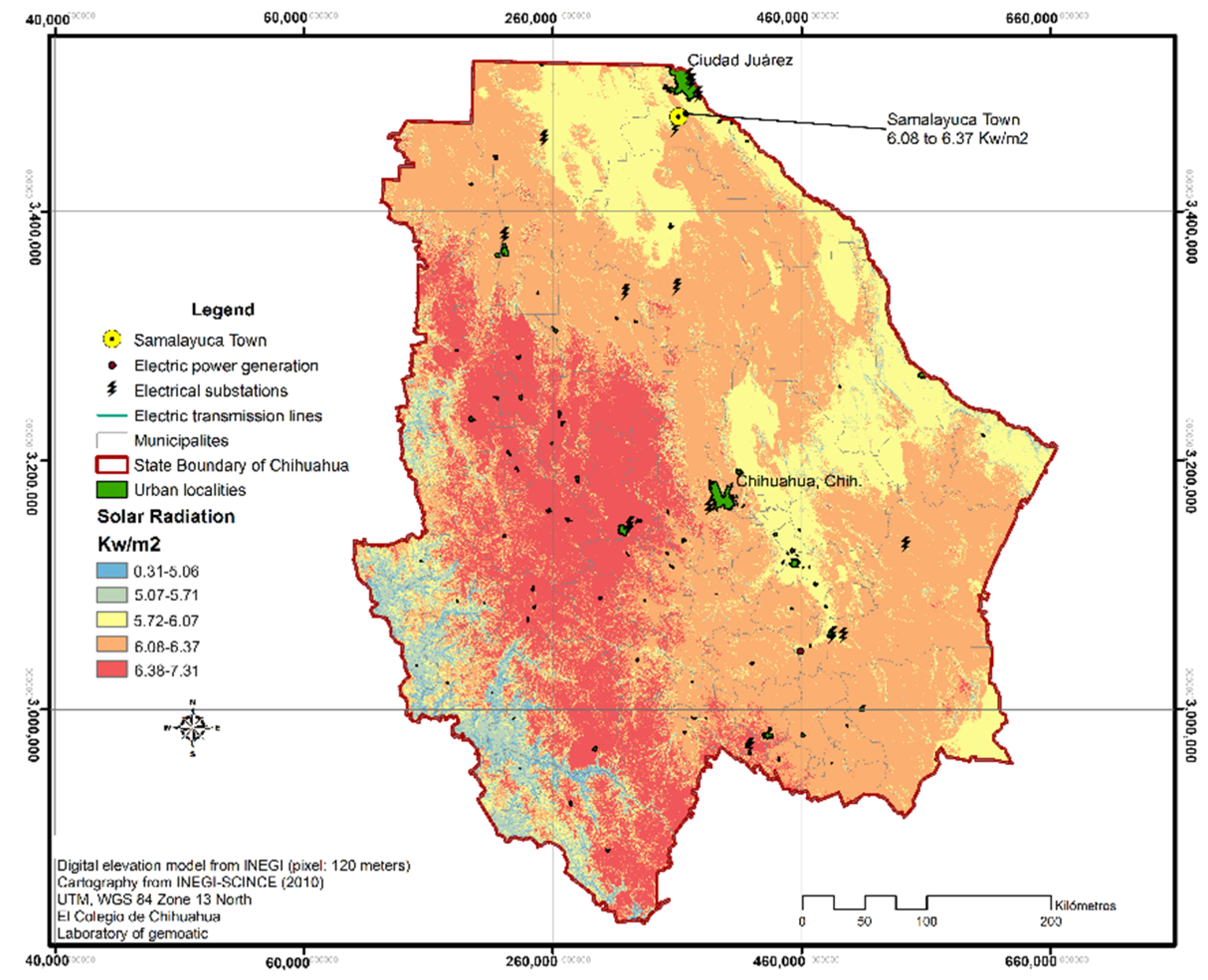
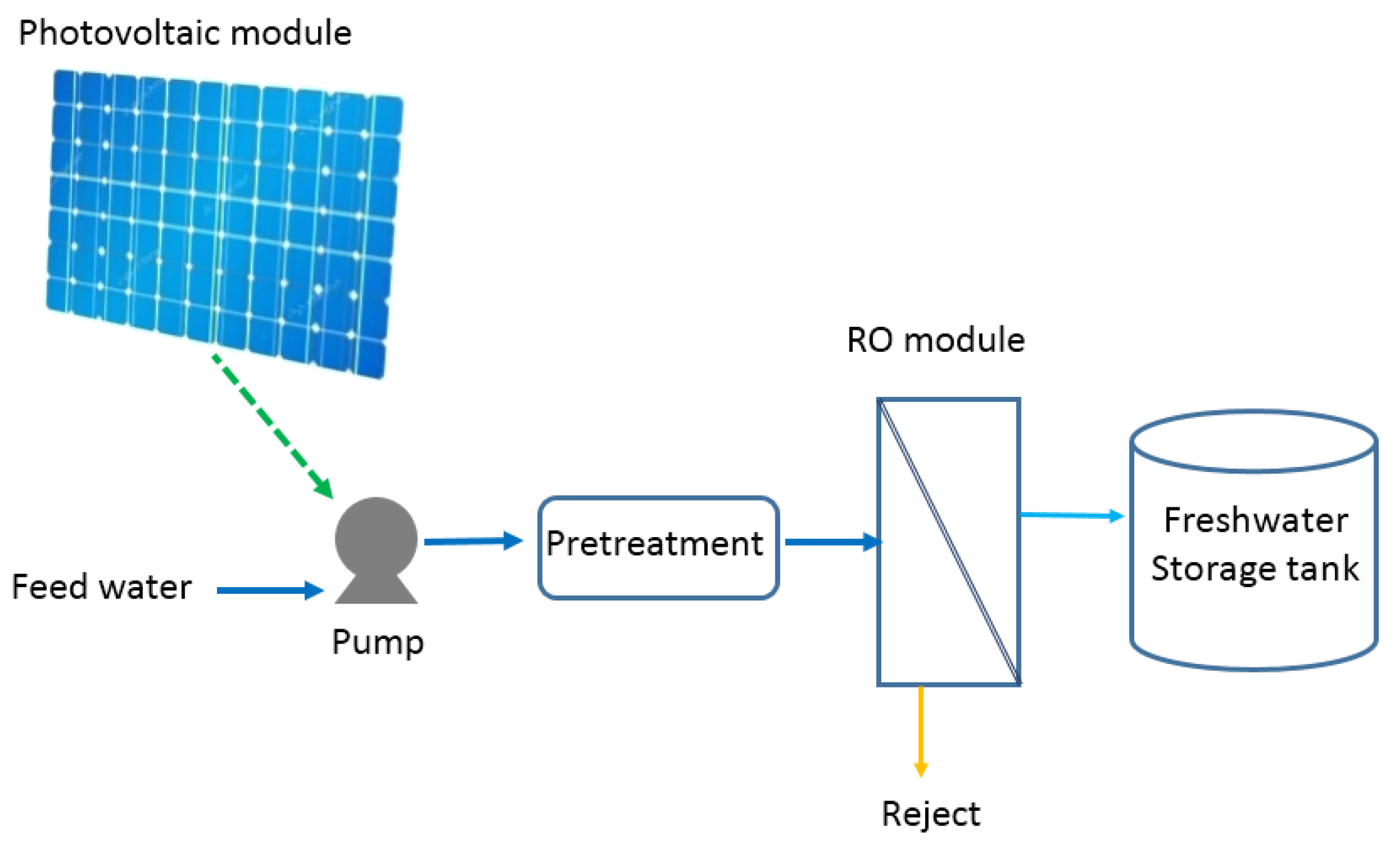

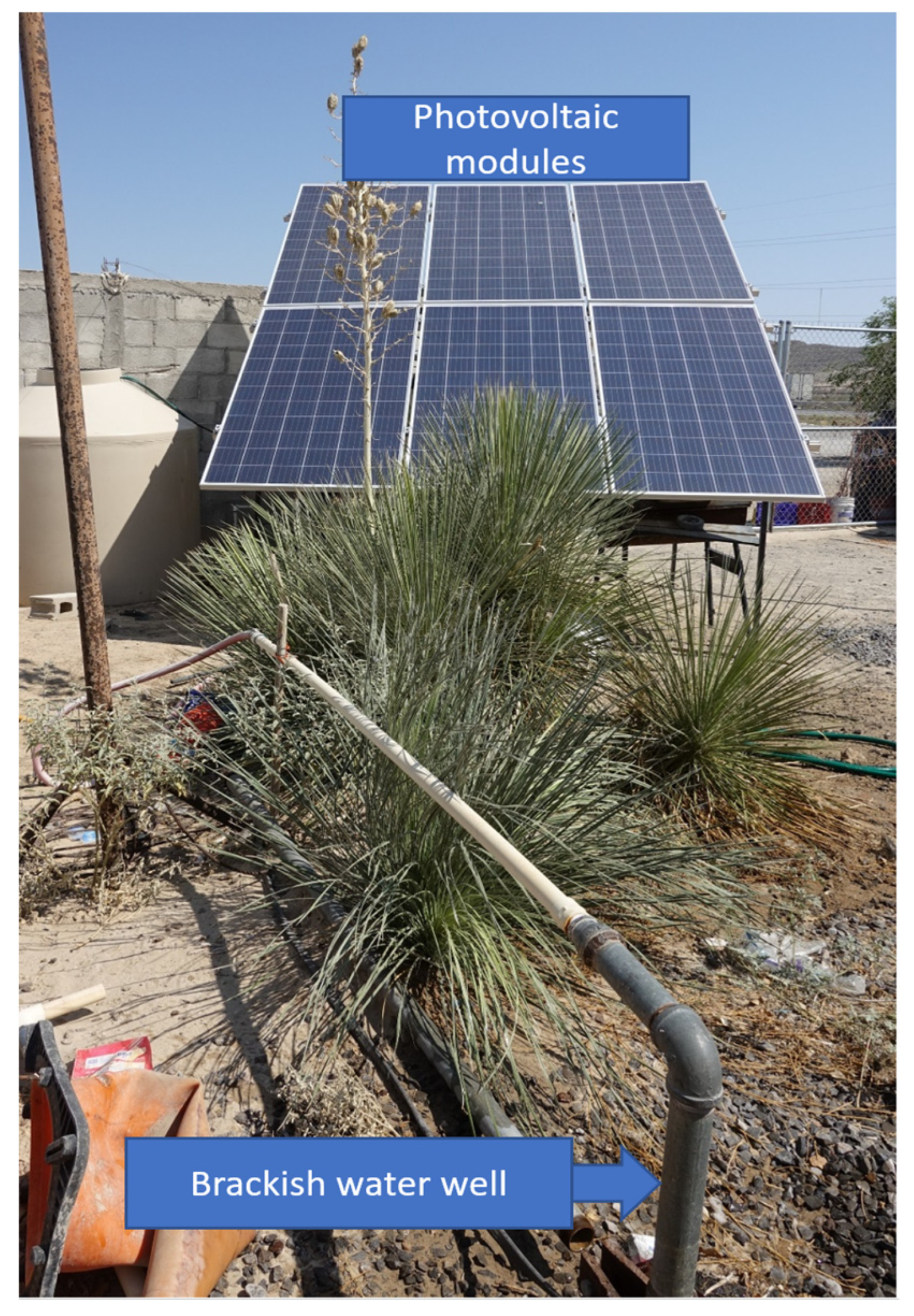
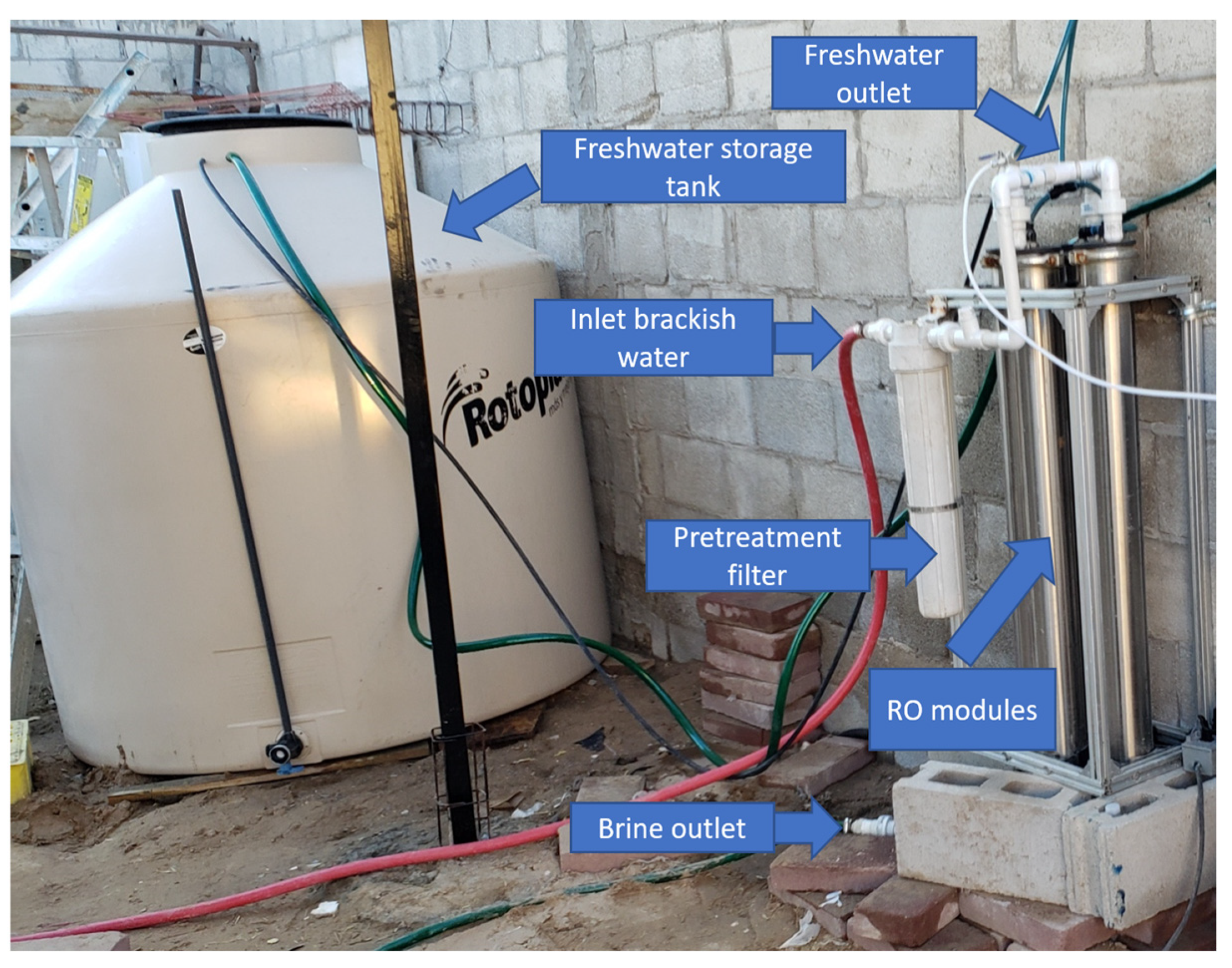
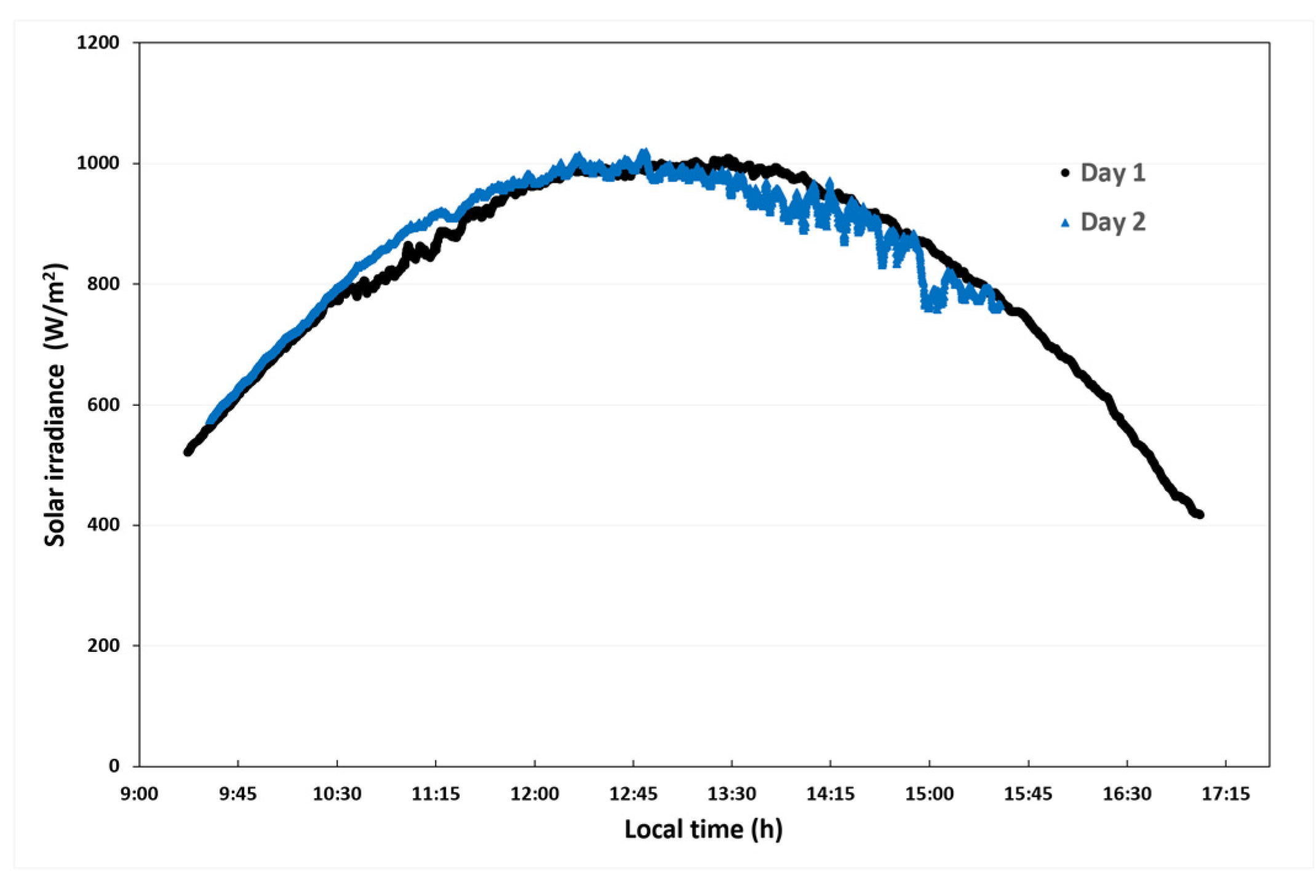
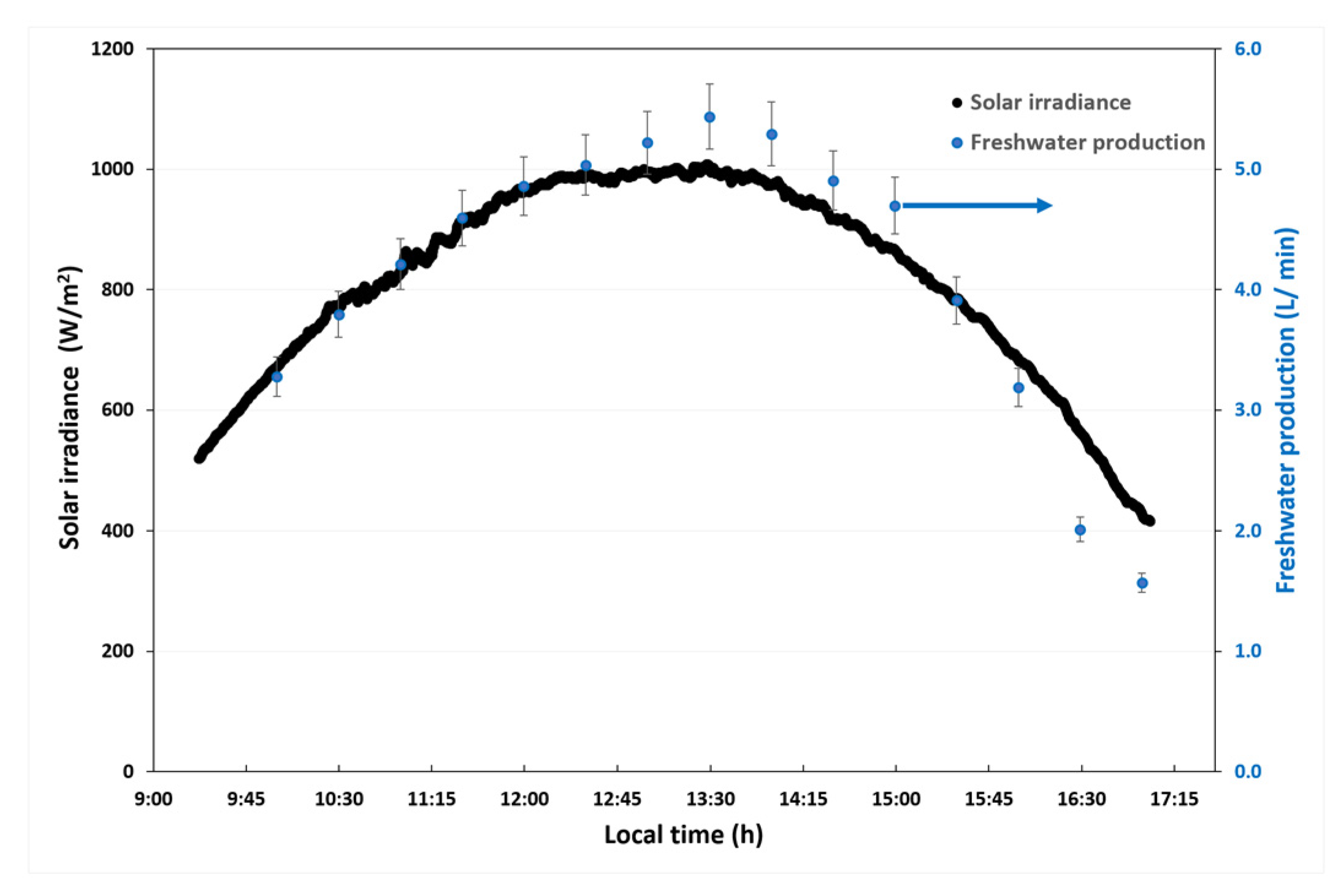
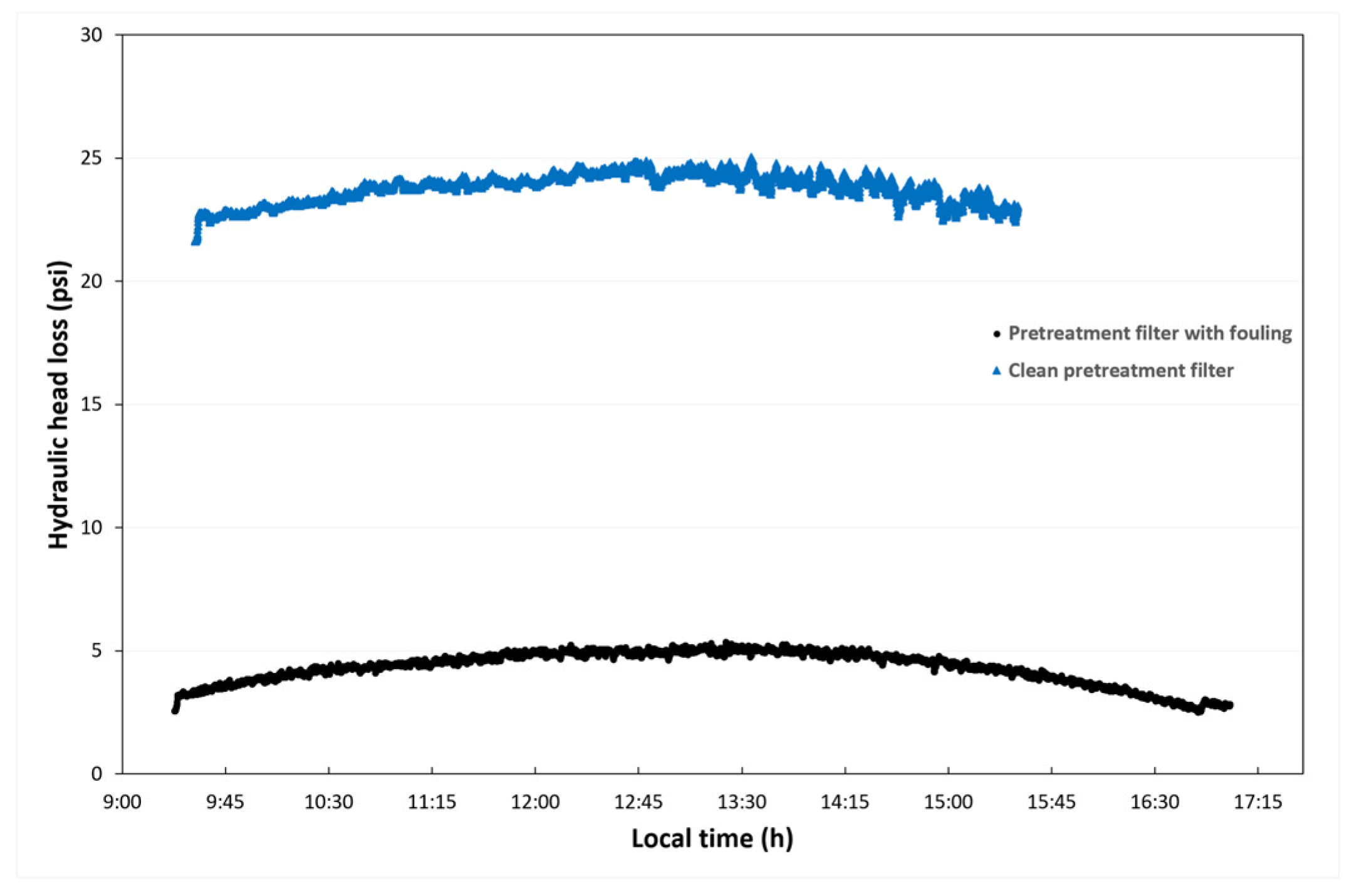
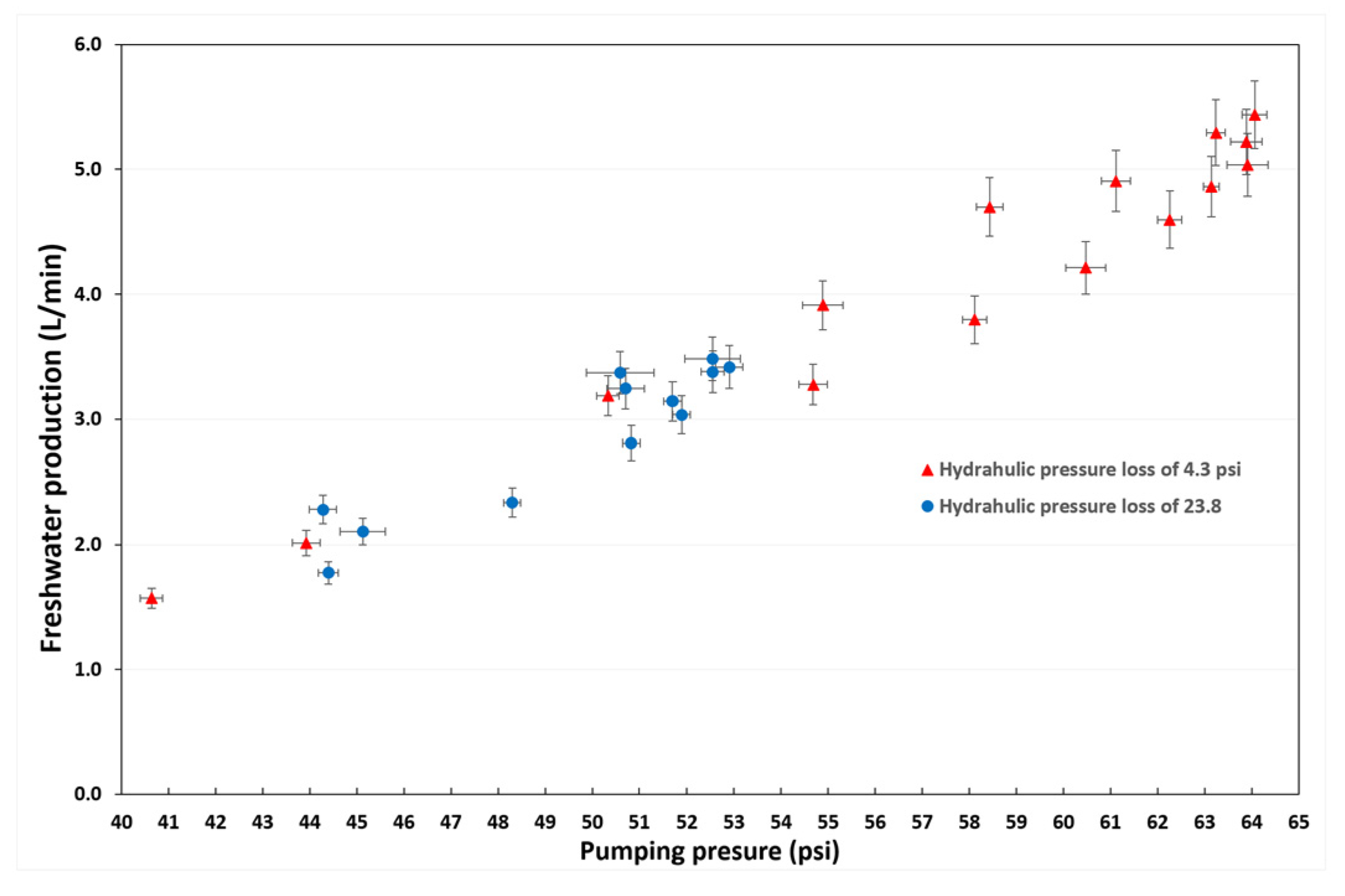
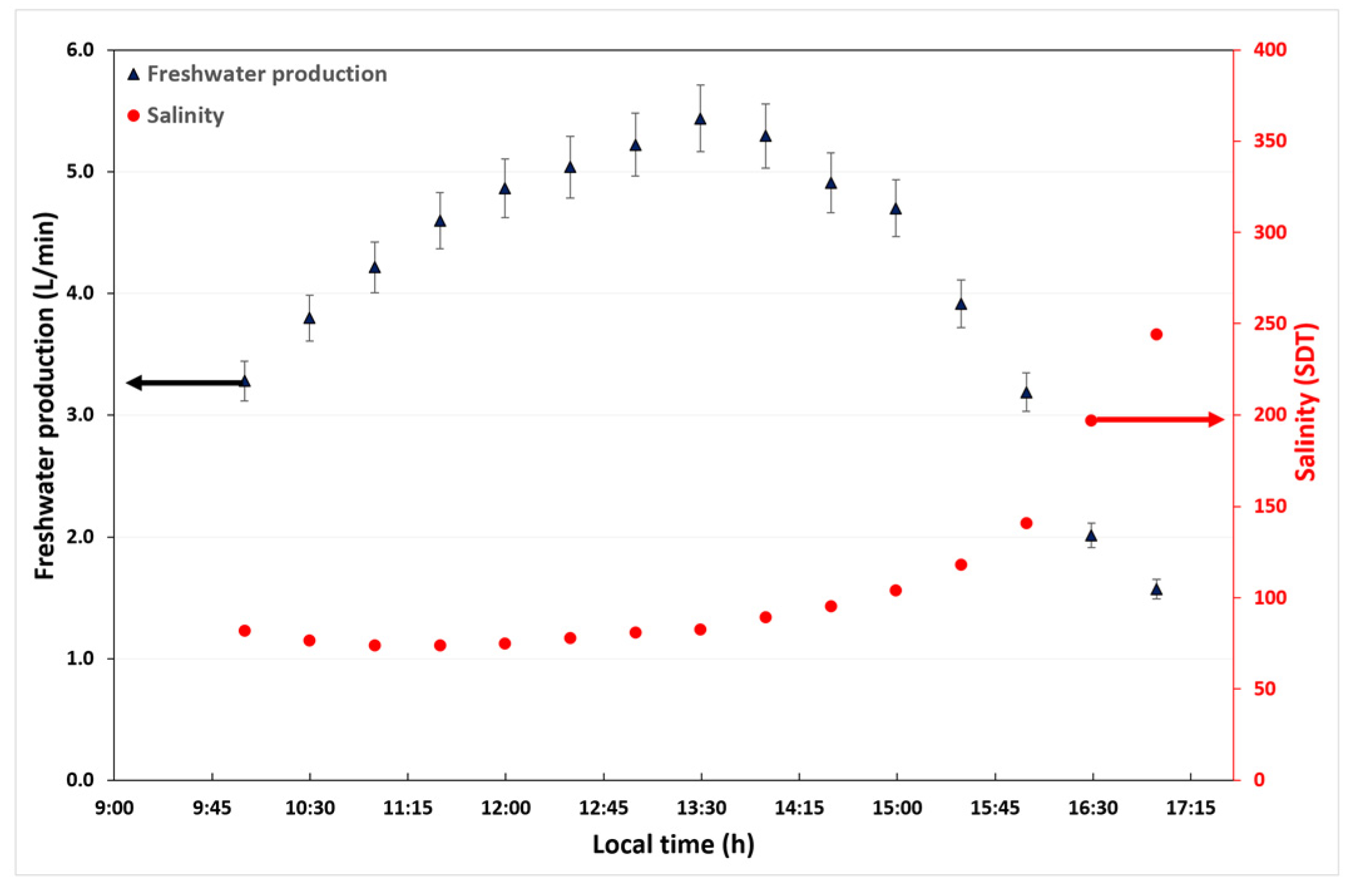
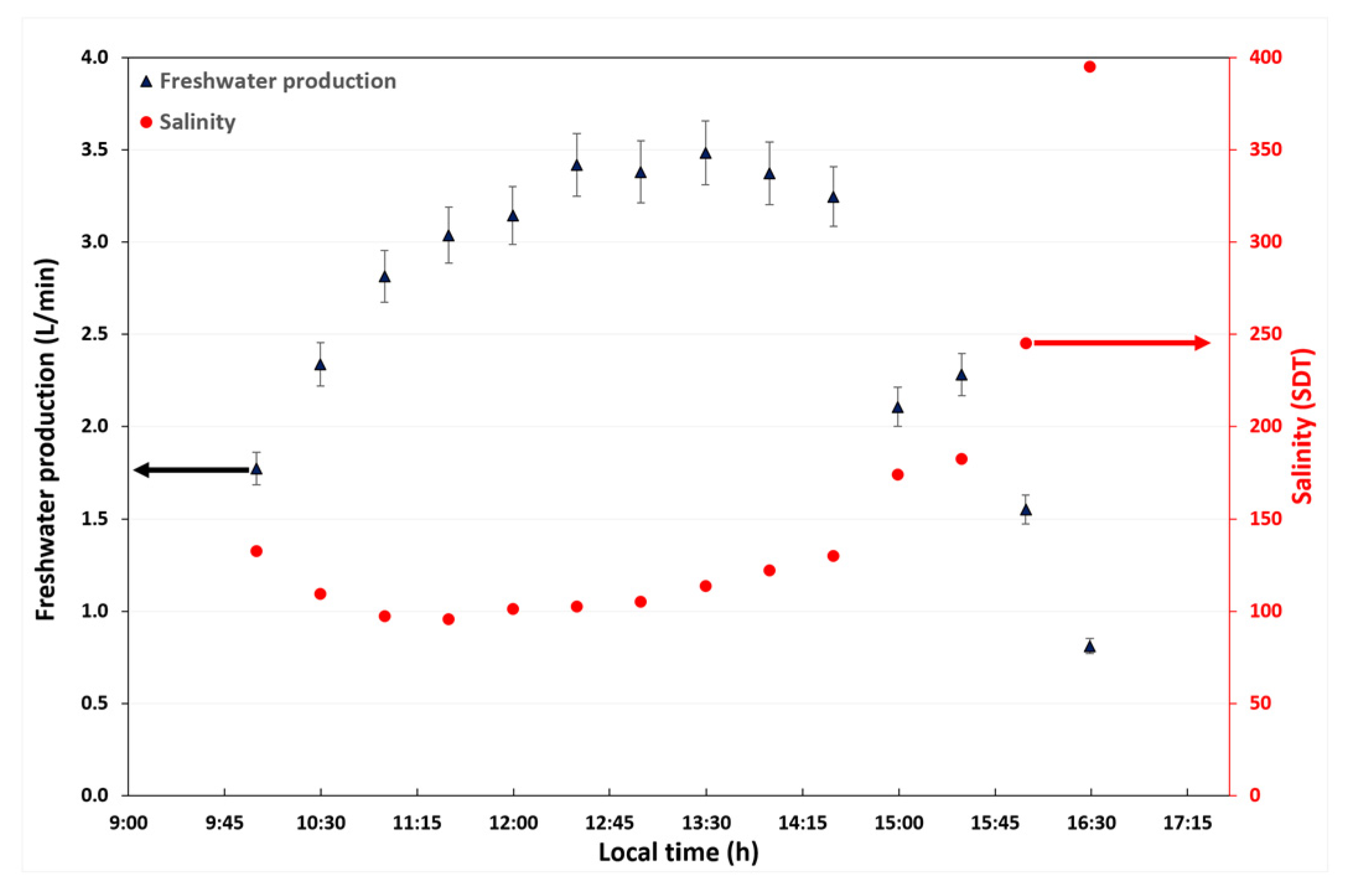



| Parameter | Sample Value | MLP |
|---|---|---|
| Electrical conductivity (µS/cm) | 6710 | Not applicable |
| Chlorides (mg/L) | 865 | 250 |
| Nitrates (mg/L) | 3.39 | 10 |
| pH | 7.53 | 6.5–8.5 |
| Total phosphorus (mg/L) | <2.45 | Not applicable |
| Sulphates (mg/L) | 2480 | 400 |
| Arsenic (mg/L) | <0.005 | 0.05 |
| Copper (mg/L) | 0.055 | 2 |
| Iron (mg/L) | 0.21 | 0.30 |
| Manganese (mg/L) | <0.050 | 0.15 |
| Potassium (mg/L) | <4.80 | Not applicable |
| Sodium (mg/L) | 826 | 200 |
| Zinc (mg/L) | 359 | 5.0 |
| Description | Value |
|---|---|
| Nominal max. power (W) | 330 |
| Operating voltage (V) | 37.2 |
| Operating current (A) | 8.88 |
| Open circuit voltage (V) | 45.6 |
| Short circuit current (A) | 9.45 |
| Instrument | Accuracy |
|---|---|
| Pressure Transducer | ±0.25% |
| First class pyranometer SR12 | ±1.8% |
| Data Acquisition / Data Logger Switch Unit | 0.003% |
| Type J Thermocouple | ±0.5% |
| Water Flow Meter | ±5% |
| Multiparameter waterproof meter | 1 ppm (mg/L) |
| Capital cost (Cc) | USD 9250.00 |
| Membrane module cost (Mc) | USD 1800 |
| Freshwater production capacity (M) | 1.8 m3/day |
| Plant availability (f) | 90% |
| Item | Cost | |
|---|---|---|
| Annual fixed charges (USD/yr) | 942.13 | |
| Membrane replacement (USD/yr) | 180.00 | |
| Operating and maintenance annual cost (USD/yr) | 188.43 | |
| Total annual payment (USD/yr) | 1310.56 | |
| Unit production cost (USD/m3) | 2.22 |
| PV Capacity (kW) | Freshwater Production (m3/day) | Freshwater Production Cost (USD/m3) | Reference |
|---|---|---|---|
| 1.54 | 1.45 | 3.00 | [20] |
| 0.54 | 1.50 | 6.50 | [21] |
| 0.30 | 1.00 | 6.50 | [22] |
| 0.54 | 1.28 | 3.60 | [21] |
| 0.60 | 1.10 | 3.70 | [23] |
| 0.48 | 0.86 | 9.0 | [24] |
| 1.98 | 1.8 | 2.22 | Present study |
| Month | Performance | Maintenance | Use |
|---|---|---|---|
| November 2019 | Water pressure (1) Time of operation (1). Total: 2 | 1 and 6 | 1 to 5 |
| December 2019 | Water pressure (1) Time of operation (1). Total: 2 | 1, 2 and 4 | Improvement to hair and skin (1 to 4) |
| January 2020 | Water pressure (1) Time of operation (1). Total: 2 | 1,2 and 4 | 1 to 4 |
| February 2020 | Water pressure (1) Time of operation (1). Total: 2 | 1 to 4 | 1 to 5 |
| March 2020 | Water pressure (2) Time of operation (2). Total: 4 | 1, 2 and 4 | Increase in personal hygiene due to the pandemic (1 to 5) |
| April 2020 | Water pressure (2) Time of operation (3). Total: 5 | 1 and 4 | 1 to 5 |
| May 2020 | Water pressure (3) Time of operation (3). Total: 6 | A small leak in the system was repaired. 1, 3, 4 y 5 | 1 to 5 |
| June 2020 | Water pressure (3) Time of operation (3). Total: 6 | 1 and 4 | Change in color in the pines, greener (1 to 5) |
| July 2020 | Water pressure (3) Time of operation (3). Total: 6 | 1 and 4 | 1 to 5 |
| August 2020 | Water pressure (3) Time of operation (3). Total: 6 | Maintenance due to high temperatures. 1, 4, 5 and 6 | 1 to 5 |
| September 2020 | Water pressure (3) Time of operation (3). Total: 6 | 4 | Share water with two homeless people (1 to 6) |
| October 2020 | Water pressure (3) Time of operation (3). Total: 6 | An irrigation system for the trees is added.1, 4 and 6 | 1 to 5 |
| November 2020 | Water pressure (3) Time of operation (1). Total: 4 | 1, 4 and 6 | 1 to 5 |
Publisher’s Note: MDPI stays neutral with regard to jurisdictional claims in published maps and institutional affiliations. |
© 2022 by the authors. Licensee MDPI, Basel, Switzerland. This article is an open access article distributed under the terms and conditions of the Creative Commons Attribution (CC BY) license (https://creativecommons.org/licenses/by/4.0/).
Share and Cite
Cervantes-Rendón, E.; Ibarra-Bahena, J.; Cervera-Gómez, L.E.; Romero, R.J.; Cerezo, J.; Rodríguez-Martínez, A.; Dehesa-Carrasco, U. Rural Application of a Low-Pressure Reverse Osmosis Desalination System Powered by Solar–Photovoltaic Energy for Mexican Arid Zones. Sustainability 2022, 14, 10958. https://doi.org/10.3390/su141710958
Cervantes-Rendón E, Ibarra-Bahena J, Cervera-Gómez LE, Romero RJ, Cerezo J, Rodríguez-Martínez A, Dehesa-Carrasco U. Rural Application of a Low-Pressure Reverse Osmosis Desalination System Powered by Solar–Photovoltaic Energy for Mexican Arid Zones. Sustainability. 2022; 14(17):10958. https://doi.org/10.3390/su141710958
Chicago/Turabian StyleCervantes-Rendón, Esmeralda, Jonathan Ibarra-Bahena, Luis E. Cervera-Gómez, Rosenberg J. Romero, Jesús Cerezo, Antonio Rodríguez-Martínez, and Ulises Dehesa-Carrasco. 2022. "Rural Application of a Low-Pressure Reverse Osmosis Desalination System Powered by Solar–Photovoltaic Energy for Mexican Arid Zones" Sustainability 14, no. 17: 10958. https://doi.org/10.3390/su141710958
APA StyleCervantes-Rendón, E., Ibarra-Bahena, J., Cervera-Gómez, L. E., Romero, R. J., Cerezo, J., Rodríguez-Martínez, A., & Dehesa-Carrasco, U. (2022). Rural Application of a Low-Pressure Reverse Osmosis Desalination System Powered by Solar–Photovoltaic Energy for Mexican Arid Zones. Sustainability, 14(17), 10958. https://doi.org/10.3390/su141710958









